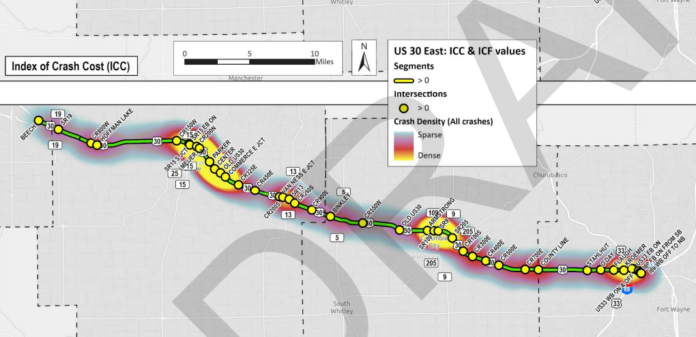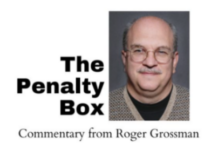
By David Slone
Times-Union
WARSAW — An important part of the U.S. 30 ProPEL study by the Indiana Department of Transportation will be presented to the public Tuesday in Columbia City and Warsaw Mayor Joe Thallemer is encouraging anyone interested to attend.
The U.S. 30 Purpose and Need draft document will be presented Tuesday, at Indian Springs Middle School, 1692 Ind. 9, Columbia City, from 5 to 7 p.m.
“This Purpose and Need is really important,” Thallemer said. “If you get on the website and get a hold of this, there’s a lot of detail of essentially what they’re going to look at. They basically developed the vision statement, the purpose – they want to enhance safety for all users, provide equitable transportation and compliment local community goals and objectives, including maintaining the character of the study area.”
The Purpose and Need report can be found here.
Along with the report and videos, there’s a button for the public to leave their comments.
Four ProPEL studies are being prepared along U.S. 30 and U.S. 31, according to the report.
This effort includes two studies along U.S. 30 from east of Valparaiso to the Indiana-Ohio state line and two studies along U.S. 31 from 276th Street in Hamilton County to its connection with U.S. 30 in Marshall County. Each of these four studies is occurring along a similar timeline and are being closely coordinated with one another to establish a shared vision to drive planning decisions for the corridors, the report states.
In the Purpose and Needs draft report, the “needs” break down into three components, Thallemer said. At the top of the list is safety for all of the users.
“They’ve identified many areas along 30 where there’s higher-than-average severity and frequency of crashes. The safety is obviously No. 1,” he said. “The second part of that though is local mobility, being able to cross and make left turns into and out of the community. And then the third need is for regional and statewide mobility, which means folks passing through.”
He said he didn’t know if any of it was really surprising from what everyone’s heard, but the report formalizes “the work they’ve done. They’ve spent the last six to eight months gathering data, gathering traffic data, crash data, talking to folks, having meetings, public meetings, website input, local meetings at the libraries, drop-in pop-up meetings. So there’s been a lot of input up to this point and what they’ve developed, this Purpose and Needs statement, is pretty much the result of that, and that is now going to set the direction for how they are going to propose these solutions.”
Thallemer said the most important thing is that people continue to be informed and provide public input.
“If that’s at the public meeting tomorrow night, please, please attend,” he said.
All the documents are available on the Propelus30.com website.
“You can see the information. You can actually see the previous presentations … tomorrow night being the last Purpose and Need meeting, the input is just so critical. But it will all be based on this report that they published May 26,” he said.
The report talks about six intersections along U.S. 30 that are “just unacceptable,” Thallemer pointed out.
The report states that “Currently, there are six intersections with failing/unacceptable traffic operations. With no action, this number is expected to grow to 12 intersections by year 2045.”
While he didn’t know the specifics, Thallemer referred to a “heat map” in the report that shows the high-crash frequencies. Warsaw has what appears to be the most concentrated issue with safety, which includes CR 325E to CR 150W.
“The other thing I noticed was that 34% of all the crashes are in the Warsaw segment, and that’s the highest of all the segments, which comes out to 24.6 crashes per mile per year. That’s a lot. The average is nine in the corridor – nine crashes per mile per year. Most of those crashes are rear-ends and right angles,” Thallemer said.
Safety is obviously the No. 1 concern.
“Here, locally in Warsaw, we’re what I would consider to be, again, the highest concentration of intersections that are performing very poorly,” Thallemer said.
After the Purpose and Need report presentation, the next step will be the Alternatives Analysis, which INDOT will be working on.
“They’re not going to come up with a specific plan. They’re going to come up with alternatives and they’re going to spend the next six months doing that, and then there will be a third public meeting,” Thallemer said. That third meeting will likely follow another published report on alternatives and be by early 2024.
The first meeting was the Vision Scoping about six months ago. The second meeting is Purpose and Need, and the third will be Alternatives Analysis.
“Once they take input on the alternatives, then probably about a year from now they will come up with a final report,” Thallemer said.
The involvement of Warsaw and Kosciusko County residents into the U.S. 30 study has been good so far, he said.
“From what I understand, there’s been good input, but a lot of that first meeting was just kind of general understanding of what was going on and I don’t think people felt like they had any direct impact on what’s going to come out of this thing. Now that they’re narrowing down the reason, purpose and need, and those locations, now folks can really identify on those locations what they would consider need done,” he said.
Another document, titled “Existing Transportation Conditions Report US 30 East,” can be found online here.
“There’s a lot there,” Thallemer said. “But I think the critical thing is safety, local mobility and then regional and statewide mobility are what they’re really looking at as far as getting this narrowed down on how they want to handle the solutions.”
He said he doesn’t think there’s any question from the study that they’ve identified that there’s a significant problem with safety in intersections that are failing or unacceptable as far as handling traffic.
“A lot of that is local traffic, and I think that’s where we really are in this county. Obviously, we want to get people safely through our community, but we have people in our community that are crossing the road and navigating U.S. 30 as a part of our community that we’re having real problems with. It’s pretty much obvious from the report,” Thallemer stated.




